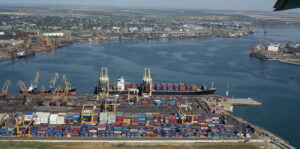
One of Ukraine’s largest grain market operators, Nibulon, has signed a contract with the seaport of Chornomorsk for the transshipment of up to 1 million tons of agricultural products in preparation for the new marketing year, the grain trader’s press service reported on Facebook.
The agricultural holding noted that the signing of this contract was a decisive step in the formation of a flexible logistics model that will allow Nibulon to maintain continuity of exports even without access to its own terminal. In addition, despite the surplus of transshipment capacity on the market, the company managed to achieve a balance of interests. Furthermore, optimized regional logistics will help create added value for Ukrainian farmers.
“Our volume and stability are tools that protect farmers. We work with over 3,000 small and medium-sized agricultural producers who, thanks to efficient logistics, receive competitive purchase prices, allowing them to plan and develop even in difficult conditions,” emphasized Sergey Kalkutin, Nibulon’s logistics director.
The company also emphasized that negotiations with other port operators are currently ongoing.
Before the war, Nibulon cultivated 82,000 hectares of land in 12 regions of Ukraine and exported agricultural products to more than 70 countries around the world. In 2021, the grain trader exported a record 5.64 million tons of agricultural products and delivered record volumes to foreign markets in August (0.7 million tons), in the fourth quarter (1.88 million tons), and in the second half of the year (3.71 million tons).
It is currently operating at 32% of its capacity, has created a special unit for demining agricultural land, and has been forced to move its central office from Mykolaiv to Kyiv.

In 2024, the ports of Greater Odesa increased their cargo handling by 2.6 times compared to 2023, to 79.9 million tons, while the Danube ports reduced this figure by 1.8 times, to 17.3 million tons, said Oleh Kiper, Head of the Odesa Regional Military Administration.
“In 2024, the ports of the region handled 97+ million tons of cargo, which is 57% more than in 2023. In particular, the ports of Greater Odesa handled 79.9 million tons, and the ports of the Danube – 17.3 million tons,” he said in a statement.
Kiper noted that these were mainly agricultural products destined for different countries of the world.
In addition, he said that during the period of operation of the sea corridor, from August 16, 2023, about 3.5 thousand vessels left the ports of Greater Odesa.
Earlier it was reported that in total, in 2023, the ports of Greater Odesa handled 30.6 million tons of cargo: the port of Chornomorsk – 11.41 million tons, Pivdennyi – 10.8 million tons, Odesa – 8.41 million tons. The sea corridor exported 12.8 million tons of cargo.
In 2023, the Danube ports handled 32 million tons of cargo.
The total cargo turnover of Ukrainian seaports in 2024 reached 97 million tons.

The cargo turnover of Ukrainian seaports in January-November 2024 reached 89.8 million tons, which is 69.7% more than in the same period last year.
“In January-November 2024, Ukrainian seaports handled 89.8 million tons of cargo, which is significantly higher than the volume of 52.9 million tons achieved in the same period in 2023. This achievement demonstrates the resilience and efficiency of the port industry even in a difficult situation,” the Ukrainian Sea Ports Authority (USPA) said on Facebook on Monday.
Agricultural products traditionally remain the mainstay of cargo traffic, with a share of 55 million tons, the report said.
At the same time, 7.5 million tons of cargo were handled in November, up 41% year-on-year. A month earlier in October, 8 million tons of cargo were handled.
Earlier, the USPA reported that the cargo turnover of Ukrainian ports from January 1 to November 17, 2024 increased to 86.8 million tons, of which 53.5 million tons were exported.

Ukraine’s ports handled 8 million tons of cargo in October, of which 6.8 million tons, or 85%, were handled through the ‘sea corridor’, State Enterprise (SE) Ukrainian Sea Ports Authority (USPA) reported on Tuesday.
The port’s performance in October is 11.5% higher than in September, when 7.178 million tons of cargo were handled, said Timur Tkachenko, Deputy Minister of Community Development, Territories and Infrastructure.
More than half of the cargo handled by ports in October was agricultural. They accounted for 5 million tons, which is almost 3.3 times more than in the same period last year, the USPA said.
Grain cargo accounted for more than half of the volume of cargo handled through the sea corridor in October – 4.5 million tons out of 6.8 million tons. The volume of ore cargo transshipment reached 1.4 million tons, which is almost twice as much as in October 2023.
Earlier it was reported that in January-October 2024, cargo handling increased by 78.1% compared to the same period in 2023 – up to 82.1 million tons from 46.1 million tons.

In January-September 2024, Ukrainian ports increased cargo transshipment by 1.8 times to 74 million tons, the state-owned Ukrainian Sea Ports Authority (USPA) reported.
“According to the operational data of USPA, from January to September 2024, Ukrainian seaports handled 74 million tons of cargo. This is a significant increase compared to the same period last year, when the volume amounted to 41.1 million tons,” the USPA said in a Facebook post on Thursday.
It is indicated that a significant part of the cargo turnover – 46.3 million tons – is agricultural products. This emphasizes its importance for the national economy and exports, the USPA said. In September, the volume of cargo handled in ports increased to 7 million tons, which is twice as much as in September 2023, when 3.4 million tons were handled, the USPA said. Of this volume, 4.1 million tons were agricultural products supplied to international markets.
Earlier it was reported that the cargo turnover of Ukrainian ports in August this year also amounted to 7 million tons. The leaders of cargo turnover are grain and ore cargo – 4 million tons and 1.2 million tons, respectively. At the same time, cargo turnover through the Ukrainian sea corridor in August amounted to 5.9 million tons, of which 3.6 million tons were products of Ukrainian farmers.
In total, in January-August 2024, Ukrainian ports handled almost 67 million tons of cargo, compared to 37.7 million tons in the same period a year earlier.

The head of the Odessa regional military administration Oleg Kiper in August 2023 by his order strengthened customs control in the region when exporting agricultural products for export, at the same time on the market of export of agricultural products appeared about 40 companies with signs of fictitiousness, reported hromadske in the investigation “Grain Baron”.
The publication noted that through the ports of Odessa in 2023 passed 85 percent of the country’s agro-exports.
When analyzing the data of the Ukrainian customs, access to which is provided by the international service ImportGenius, journalists found 40 companies with signs of fictitiousness, which entered the agro export market after the Odessa OSA established “manual control” over it.
These companies started exporting grain after August 2023. They have never engaged in exports before, were founded or changed owners in 2023, are not part of well-known agroholdings and do not own land.
“The largest by export volume of these firms has the same phone number as another 139 legal entities. And in second place is a company whose founder is probably a psychologist from Uzbekistan, for whom 20 legal entities have been registered in Ukraine over the past two years,” the investigation said.
“Suspicious” companies for the last quarter of 2023 exported through the ports of the Odessa region about 800 thousand tons of agricultural products worth about $ 150 million, or 6 billion UAH, says the publication and recalls that the head of the Odessa Regional State Administration explained the establishment of manual control by the need to fight against one-day companies and so-called “black exports”.
Such one-day companies export grain and do not return foreign currency proceeds to the country, do not pay taxes, have a fake director and do not have an office. After several transactions with a budget of several million dollars, the company disappears.
The chairman of the All-Ukrainian Agrarian Union “Agrarnaya Rada” Dmytro Kohan drew attention to the fact that any manual control has increased risks of corruption.
The Odessa regional military administration refused to comment on the facts revealed by journalists.